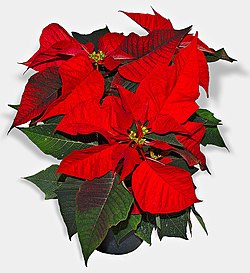 | ||||||||||||||
| Scientific classification | ||||||||||||||
|---|---|---|---|---|---|---|---|---|---|---|---|---|---|---|
| ||||||||||||||
| Binomial name | ||||||||||||||
| Euphorbia pulcherrima Willd. ex Klotzsch |
Commonly named poinsettia, is a species of flowering plant indigenous to Mexico and Guatemala. The name "poinsettia" is after Joel Roberts Poinsett, the first United States Minister to Mexico,[1] who introduced the plant into the US in 1828.
n areas outside its natural environment it is commonly grown as an indoor plant where it prefers good morning sun then shade in the hotter part of the day. However, it is widely grown and very popular in subtropical climates such as Sydney, Australia.
As this is a subtropical plant, it will likely perish if the night-time temperature falls below 10°C (50°F) so is not suitable for planting in the ground in cooler climates. Likewise, daytime temperatures in excess of 21°C (70°F) tend to shorten the lifespan of the plant.[citation needed]
The poinsettia is also cultivated in Egypt since 1860s, it was brought from Mexico during Egyptian campaign around 1860s. It is called "Bent El Consul", "the consul's daughter", referring to U.S. ambassador Mr. Poinsett.[citation needed]
The poinsettia can be difficult to induce to reflower after the initial display when purchased. The plant requires a period of uninterrupted long, dark nights for around two months in autumn in order to develop flowers. Incidental light at night during this time will hamper flower production. When watering it is important to allow the plant to drain out any excess water. Having a poinsettia sit in water can do harm to the plant as it prefers moist soil to direct water.
In order to produce extra axillary buds that are necessary for plants containing multiple flowers, a phytoplasma infection – whose symptoms include the proliferation of axillary buds – is used..jpg)


0 comments:
Post a Comment